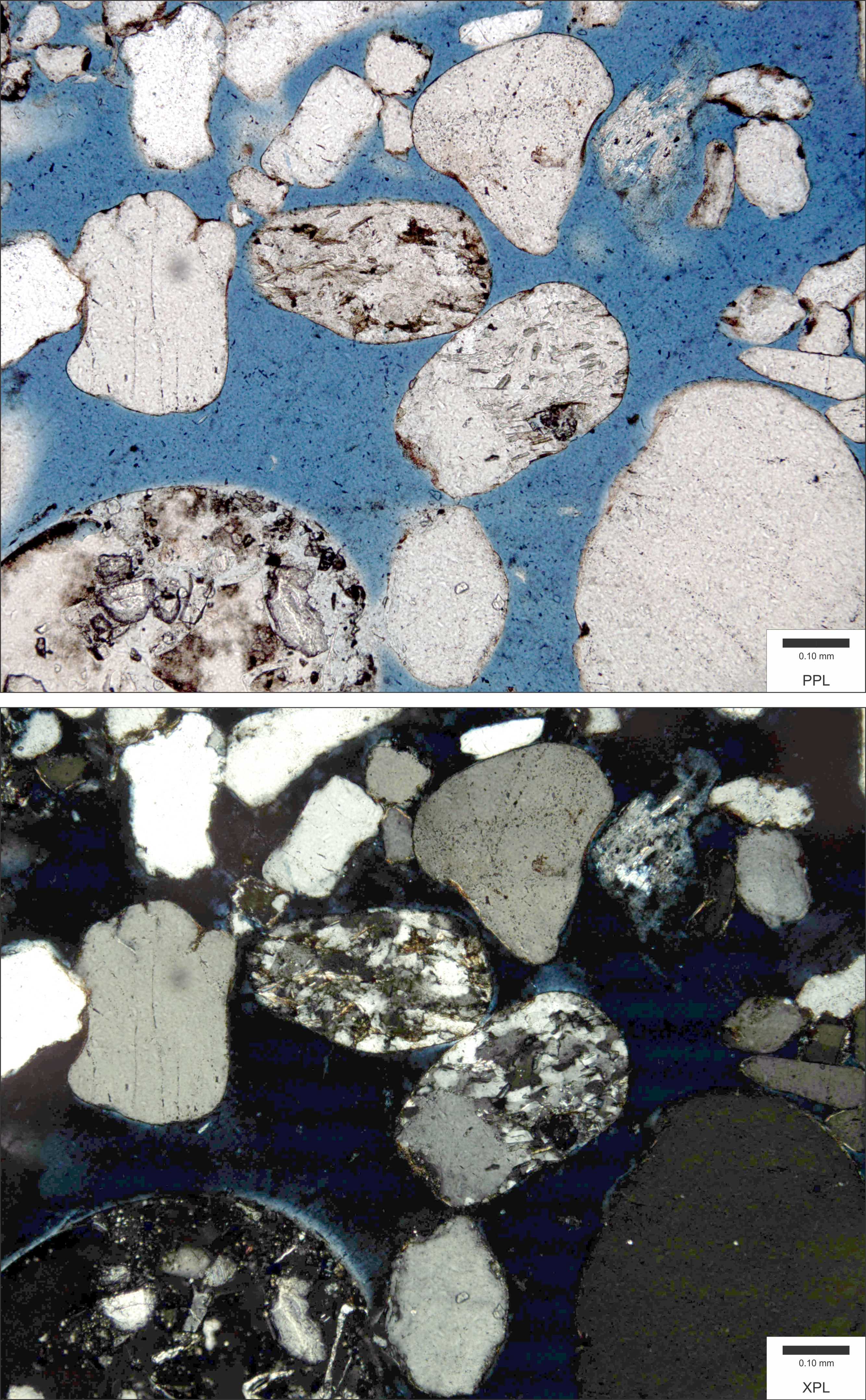lithic sandstone on:
[Wikipedia]
[Google]
[Amazon]
 Lithic sandstones, or lithic arenites, or litharenites, are
Lithic sandstones, or lithic arenites, or litharenites, are
 Lithic sandstones, or lithic arenites, or litharenites, are
Lithic sandstones, or lithic arenites, or litharenites, are sandstone
Sandstone is a clastic sedimentary rock composed mainly of sand-sized (0.0625 to 2 mm) silicate grains. Sandstones comprise about 20–25% of all sedimentary rocks.
Most sandstone is composed of quartz or feldspar (both silicates ...
s with a significant (>5%) component of lithic fragments, though quartz
Quartz is a hard, crystalline mineral composed of silica ( silicon dioxide). The atoms are linked in a continuous framework of SiO4 silicon-oxygen tetrahedra, with each oxygen being shared between two tetrahedra, giving an overall chemical ...
and feldspar
Feldspars are a group of rock-forming aluminium tectosilicate minerals, also containing other cations such as sodium, calcium, potassium, or barium. The most common members of the feldspar group are the ''plagioclase'' (sodium-calcium) felds ...
are usually present as well, along with some clayey matrix. Lithic sandstones can have a speckled (salt and pepper) or gray color, and are usually associated with one specific type of lithic fragment (i.e., igneous
Igneous rock (derived from the Latin word ''ignis'' meaning fire), or magmatic rock, is one of the three main rock types, the others being sedimentary and metamorphic. Igneous rock is formed through the cooling and solidification of magma or ...
, sedimentary
Sedimentary rocks are types of rock that are formed by the accumulation or deposition of mineral or organic particles at Earth's surface, followed by cementation. Sedimentation is the collective name for processes that cause these particles ...
, or metamorphic
Metamorphic rocks arise from the transformation of existing rock to new types of rock in a process called metamorphism. The original rock (protolith) is subjected to temperatures greater than and, often, elevated pressure of or more, causi ...
).Prothero, D. R. and Schwab, F., 1996, Sedimentary Geology, pg. 100,
Tectonically, lithic sandstones often form in a wide variety sedimentary depositional environment
In geology, depositional environment or sedimentary environment describes the combination of physical, chemical, and biological processes associated with the deposition of a particular type of sediment and, therefore, the rock types that will be ...
s (including fluvial, deltaic
A river delta is a landform shaped like a triangle, created by deposition of sediment that is carried by a river and enters slower-moving or stagnant water. This occurs where a river enters an ocean, sea, estuary, lake, reservoir, or (more rarel ...
, and alluvial
Alluvium (from Latin ''alluvius'', from ''alluere'' 'to wash against') is loose clay, silt, sand, or gravel that has been deposited by running water in a stream bed, on a floodplain, in an alluvial fan or beach, or in similar settings. All ...
sediments) associated with active margin
Active may refer to:
Music
* ''Active'' (album), a 1992 album by Casiopea
* Active Records, a record label
Ships
* ''Active'' (ship), several commercial ships by that name
* HMS ''Active'', the name of various ships of the British Royal ...
s. This tectonic
Tectonics (; ) are the processes that control the structure and properties of the Earth's crust and its evolution through time. These include the processes of mountain building, the growth and behavior of the strong, old cores of continents ...
setting provides the source of the lithic fragments, either through arc volcanism, thin-skinned faulting, continental collisions, unroofing, and subduction roll-back.
See also
* Arkose *Quartz arenite
A quartz arenite or quartzarenite is a sandstone composed of greater than 90% detrital quartz. Quartz arenites are the most mature sedimentary rocks possible, and are often referred to as ultra- or super-mature, and are usually cemented by sili ...
References